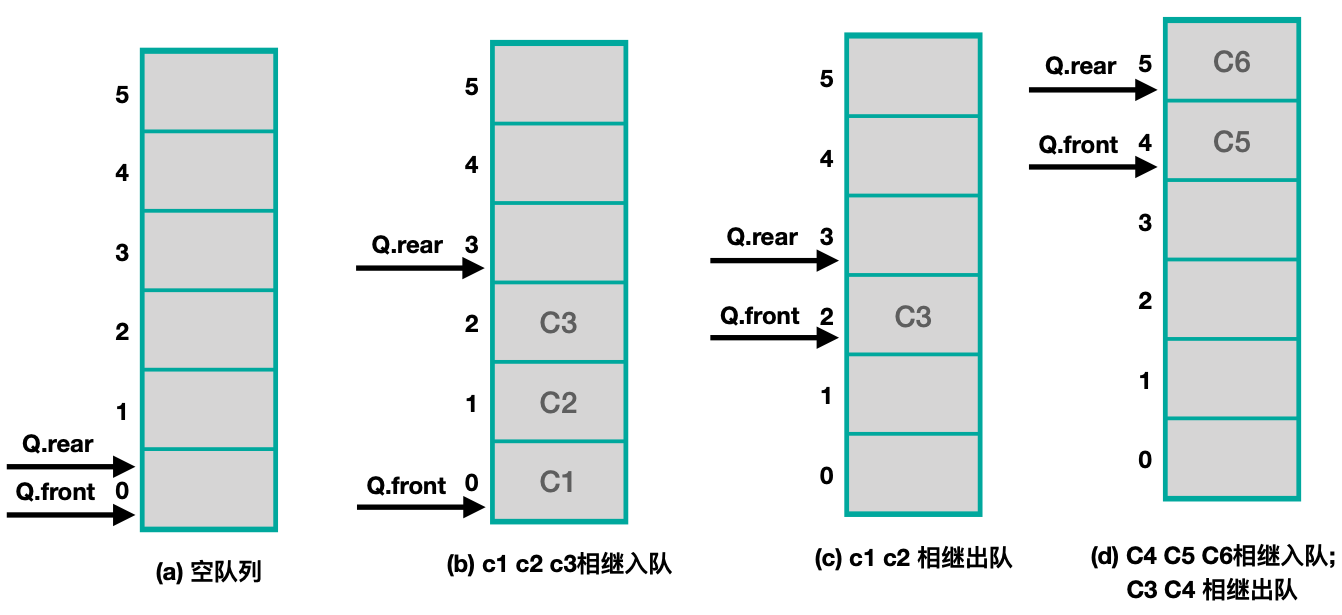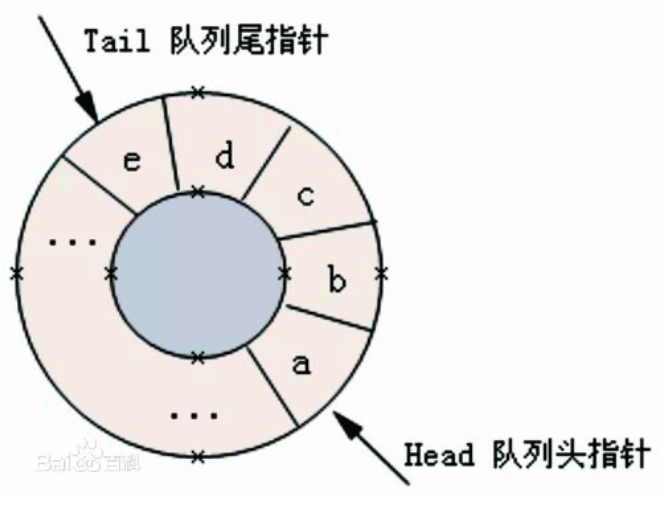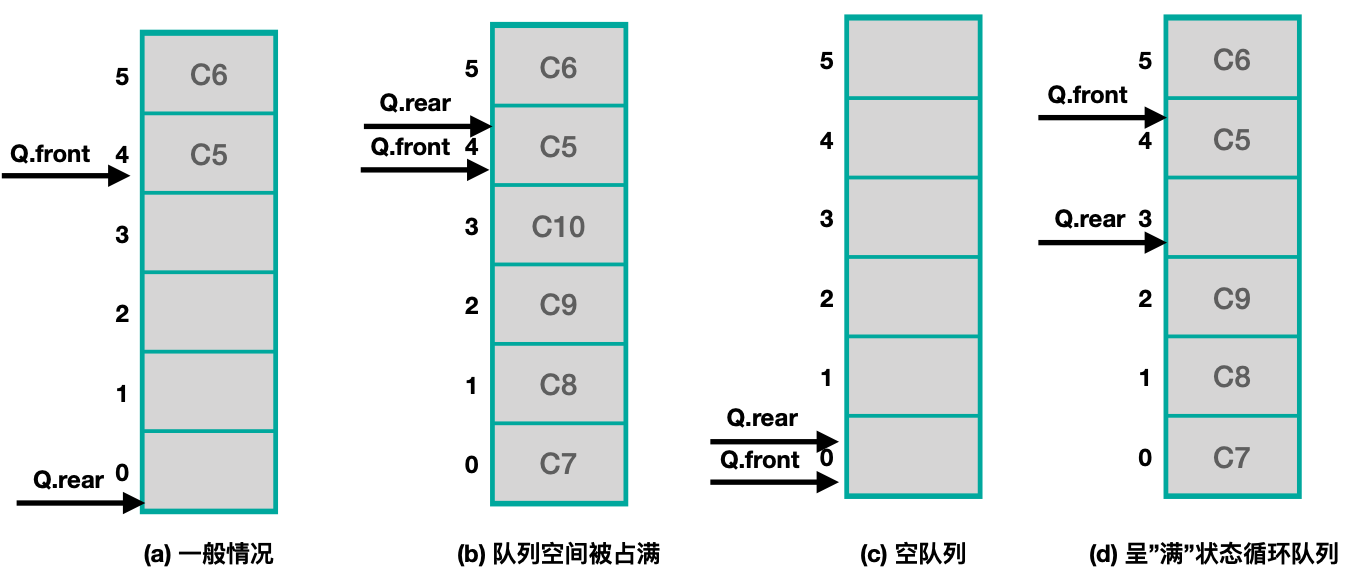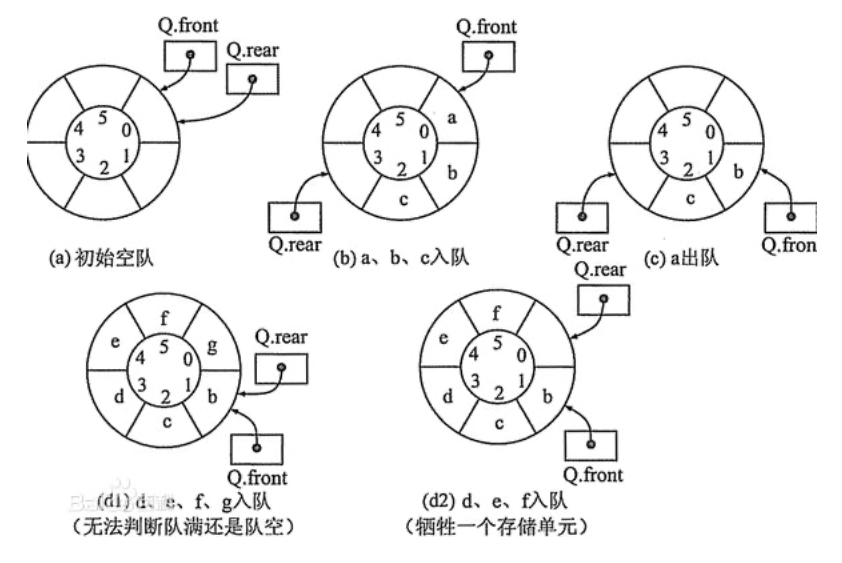1 定义
队列和栈一样是一种重要的数据结构。不同于栈“先进后出”的规则,它正如其名,是一种“先进先出(FIFO-First In First Out)”的结构。
在生活中,我们买东西排队就是典型的队列结构:先入队的人先买先出列,后入队的人需等待前面的数据元素出队。
在开发中,执行多任务、创建数据缓冲区等都是队列结构的应用。下面将介绍队列的具体实现。
2 顺序存储队列
首先,使用顺序存储的方式创建一块连续的内存,以数组的形式保存队列中的数据元素。
新元素入队则添加在数组中原有元素的后面。出队时则将首个元素移除,并需要将所有元素向前移动一格,这种数据移动会产生不必要的计算。所以采用如下的管理方式。

使用两个下标 rear front来标记队列的对头和队尾。入队时在rear 出插入数据,出队时在 front 出移除数据。这样就避免了不必要的数据移动操作。
如果队尾 rear 移动到了空间的最后一格,此时如果有新的元素入队,因为空间是固定的不能开辟新的空间,并且之前的空间已被释放,如果不用则会造成浪费,所以在此基础上提出了循环队列的概念。

当队尾 rear 移动到最后的一格入队时,会让队尾 rear 重新回到空间的起始位置,将新的数据元素插入到前面已被释放的空间中,使空间循环地利用。队列通过两个队标来判断当前的状态,循环可以通过取模运算 % 来实现。
在数据元素为空时, 队头front 与队尾 rear 都指向空间的起始地址。当数据元素存满时,队头front 与队尾 rear 又指向同样的地址,此时将无法判断队列是空的还是满的。为解决这个问题,我们将牺牲一个存储单元作为标记,规定队头front 在队尾 rear 前面距离一个存储单元时队列为满的状态,如下图所示:

图 c 表示队列开始的状态。当元素不断地入队后成为图 d 时,则认为当前队列已满,以区分队列为空的状态。
下图展示了将物理内存“掰弯”后,队列结构的操作顺序:

2.1 结构定义
/// 设置队列的长度
#define MAXSIZE 10
/// 顺序存储队列结构
typedef struct {
ElementType data[MAXSIZE]; // 连续内存空间
int front; // 对头下标,指向对头元素
int rear; // 队尾下标,指向队尾元素的下一个位置
} Queue;
2.2 队列常用方法
/// 初始化顺序存储队列
static Status queueInit(Queue *q) {
q->front = 0;
q->rear = 0;
return SUCCESS;
}
/// 清空顺序存储队列
static Status queueClear(Queue *q) {
// 数据不需要抹除,只需改变下标位置
q->front = 0;
q->rear = 0;
return SUCCESS;
}
/// 判断队列是否为空
static int queueIsEmpty(Queue q) {
if (q.front == q.rear) {
return 1;
}
return 0;
}
/// 判断队列是否已满
static int queueIsFull(Queue q) {
if ((q.rear + 1) % MAXSIZE == q.front) {
return 1;
}
return 0;
}
/// 获取队列的长度
static int queueLength(Queue q) {
return (q.rear - q.front + MAXSIZE) & MAXSIZE;
}
/// 获取队头元素
static Status getHeadElement(Queue q, ElementType *e) {
// 空队列判断
if (q.front == q.rear) {
return ERROR;
}
// 队头元素
*e = q.data[q.front];
return SUCCESS;
}
/// 遍历打印队列的数据元素
static Status queueTraverse(Queue q) {
int i = q.front;
printf("[队头-队尾]Queue: ");
while (i != q.rear) {
printf("%d ", q.data[i]);
i = (i + 1) % MAXSIZE;
}
printf("\n");
return SUCCESS;
}
2.3 入队
/// 数据元素入队
static Status enqueue(Queue *q, ElementType e) {
// 队列已满判断
if ((q->rear + 1) % MAXSIZE == q->front) {
return ERROR;
}
// 队尾设置新的数据
q->data[q->rear] = e;
// 改变队尾位置,加一取模
q->rear = (q->rear + 1) % MAXSIZE;
return SUCCESS;
}
2.4 出队
/// 数据元素出队
static Status dequeue(Queue *q, ElementType *e) {
// 空队列判断
if (q->front == q->rear) {
return ERROR;
}
// 返回数据元素的数据
*e = q->data[q->front];
// 改变队头位置
q->front = (q->front + 1) % MAXSIZE;
return SUCCESS;
}
2.5 使用
int main() {
Queue q;
printf("队列初始化\n");
queueInit(&q);
queueTraverse(q);
printf(queueIsEmpty(q) ? "\n队列是空的\n" : "\n队列不为空\n");
printf("\n构建队列\n");
for (int i = 0; i < 10; i++) {
ElementType element = i * 4 + 1;
enqueue(&q, element);
}
printf(queueIsFull(q) ? "\n队列是满的\n" : "\n队列没有满\n");
queueTraverse(q);
printf("队列的元素个数为 %d\n", queueLength(q));
ElementType head;
getHeadElement(q, &head);
printf("队头的元素数据为 %d\n", head);
ElementType e = 666;
printf("\n入队 ← %d\n", e);
enqueue(&q, e);
queueTraverse(q);
ElementType e1;
dequeue(&q, &e1);
printf("\n出队 → %d\n", e1);
queueTraverse(q);
ElementType e2;
dequeue(&q, &e2);
printf("\n出队 → %d\n", e2);
queueTraverse(q);
printf("\n清空队列 x\n");
queueClear(&q);
queueTraverse(q);
return 0;
}
打印结果:
队列初始化
[队头-队尾]Queue:
队列是空的
构建队列
队列是满的
[队头-队尾]Queue: 1 5 9 13 17 21 25 29 33
队列的元素个数为 2
队头的元素数据为 1
入队 ← 666
[队头-队尾]Queue: 1 5 9 13 17 21 25 29 33
出队 → 1
[队头-队尾]Queue: 5 9 13 17 21 25 29 33
出队 → 5
[队头-队尾]Queue: 9 13 17 21 25 29 33
清空队列 x
[队头-队尾]Queue:
3 链式存储队列
链式存储由于不受起始空间的限制,所以不存在顺序存储队列所存在的位置计算问题,在实现上要比顺序存储简单一些。
3.1 结构定义
/*
/// 设置队列的长度
#define MAXSIZE 10
/// 顺序存储队列结构
typedef struct {
ElementType data[MAXSIZE]; // 连续内存空间
int front; // 对头下标,指向对头元素
int rear; // 队尾下标,指向队尾元素的下一个位置
} Queue;
*/
/// 队节点结构
/// next 指向下一个要出队的元素
typedef struct QueueNode {
ElementType data; // 数据域
struct QueueNode *next; // 后继指针
} *QueueNodePtr;
/// 队列结构创建
typedef struct {
QueueNodePtr front; // 队头位置
QueueNodePtr rear; // 队尾位置
} LinkQueue;
3.1 初始化
/// 初始化顺序存储队列
static Status queueInit(LinkQueue *q) {
// 创建头结点作为辅助节点
QueueNodePtr head = (QueueNodePtr)malloc(sizeof(struct QueueNode));
if (!head) {
return ERROR;
}
head->next = NULL;
// 队头队尾指向新的节点
q->front = q->rear = head;
return SUCCESS;
}
在初始化中,创建了一个头结点作为链表的辅助节点,和前几节中链表的头结点作用一样,为了避免首节点的判断操作。此时,front->next 才是链表的首元节点,也就是队头元素。当队列为空时,队头 front 队尾 rear 都指向这个头结点。
3.2 清空
/// 清空顺序存储队列
static Status queueClear(LinkQueue *q) {
// 获取队头元素
QueueNodePtr p = q->front->next;
QueueNodePtr temp;
// 遍历释放各节点
while (p) {
temp = p;
free(temp);
p = p->next;
}
// 重置队头与队尾
q->front->next = NULL;
q->rear = q->front;
return SUCCESS;
}
/// 销毁顺序存储队列
static Status queueDestroy(LinkQueue *q) {
// 释放所有节点和头结点
while (q->front) {
// 利用 q->rear 作为 temp
q->rear = q->front->next;
free(q->front);
q->front = q->rear;
}
// 注意 while 中的顺序,保证 rear 和 front 都为 NULL
return SUCCESS;
}
3.3 队列常用方法
/// 判断队列是否为空
static int queueIsEmpty(LinkQueue q) {
if (q.front == q.rear) {
return 1;
}
return 0;
}
/// 获取队列的长度
static int queueLength(LinkQueue q) {
int len = 0;
QueueNodePtr p = q.front;
// 队头到队尾遍历计算长度
while (p != q.rear) {
p = p->next;
len++;
}
return len;
}
/// 获取队头元素
static Status getHeadElement(LinkQueue q, ElementType *e) {
// 空队列判断
if (q.front == q.rear) {
return ERROR;
}
// 队头元素()
*e = q.front->next->data;
return SUCCESS;
}
/// 遍历打印队列的数据元素
static Status queueTraverse(LinkQueue q) {
QueueNodePtr p = q.front->next;
printf("[队头-队尾]Queue: ");
while (p) {
printf("%d ", p->data);
p = p->next;
}
printf("\n");
return SUCCESS;
}
3.4 入队
/// 数据元素入队
static Status enqueue(LinkQueue *q, ElementType e) {
QueueNodePtr temp = (QueueNodePtr)malloc(sizeof(struct QueueNode));
if (!temp) {
return ERROR;
}
temp->data = e;
temp->next = NULL;
// 添加到队尾,即链表后面
q->rear->next = temp;
// 移动队尾位置
q->rear = temp;
return SUCCESS;
}
3.5 出队
/// 数据元素出队
static Status dequeue(LinkQueue *q, ElementType *e) {
// 空队列判断
if (q->front == q->rear) {
return ERROR;
}
// 出队列的节点
QueueNodePtr temp = q->front->next;
// 改变队头位置
q->front->next = temp->next;
// 队头也是队尾,即只有一个元素,则重置队尾
if (temp == q->rear) {
q->rear = q->front;
}
// 返回数据元素的数据
*e = temp->data;
// 释放节点
free(temp);
return SUCCESS;
}
3.6 使用
int main() {
LinkQueue q;
printf("队列初始化\n");
queueInit(&q);
queueTraverse(q);
if (queueIsEmpty(q)) {
printf("\n队列是空的\n");
} else {
printf("\n队列不为空\n");
}
printf("\n构建队列\n");
for (int i = 0; i < 6; i++) {
ElementType element = i * 2 + 3;
enqueue(&q, element);
}
queueTraverse(q);
printf("队列的元素个数为 %d\n", queueLength(q));
ElementType head;
getHeadElement(q, &head);
printf("队头的元素数据为 %d\n", head);
ElementType e = 777;
printf("\n入队 ← %d\n", e);
enqueue(&q, e);
queueTraverse(q);
ElementType e1;
dequeue(&q, &e1);
printf("\n出队 → %d\n", e1);
queueTraverse(q);
ElementType e2;
dequeue(&q, &e2);
printf("\n出队 → %d\n", e2);
queueTraverse(q);
printf("\n清空队列 x\n");
queueClear(&q);
queueTraverse(q);
return 0;
}
打印结果:
队列初始化
[队头-队尾]Queue:
队列是空的
构建队列
[队头-队尾]Queue: 3 5 7 9 11 13
队列的元素个数为 6
队头的元素数据为 3
入队 ← 777
[队头-队尾]Queue: 3 5 7 9 11 13 777
出队 → 3
[队头-队尾]Queue: 5 7 9 11 13 777
出队 → 5
[队头-队尾]Queue: 7 9 11 13 777
清空队列 x
[队头-队尾]Queue: